Talking Points:
- The U.S. Dollar is on the move after a strong read for Advanced Retail Sales brought a bid to the Greenback.
- This move of strength in the Dollar has created weakness in EUR/USD and GBP/USD, each looked at below.
- If you’re looking for trade ideas, check out our Trading Guides. And if you’re looking for shorter-term ideas, please check out our IG Client Sentiment.
To receive James Stanley’s Analysis directly via email, please sign up here.
In yesterday’s article, we looked at the rather busy data outlay for this week, key of which is a series of European prints that could provide that next boost of motivation to the single currency. Earlier this morning brought the first of those data points to the fray, as German GDP numbers for Q2 were released. This was the first read of 2nd quarter GDP growth, and Europe’s largest economy grew by .6%, which was below the estimate of .7%. But – this does keep Germany on pace for the economy’s fastest growth since 2014, as Germany’s year-over-year GDP growth was pushed up to 2.1%.
The bigger release is tomorrow, as GDP growth for the Euro-Zone is released, and on Thursday, we get minutes from the most recent ECB meeting. This was the ECB meeting where markets pretty much directly faded Mario Draghi as he was speaking: After previous ECB meetings saw Mr. Draghi take a dovish tone, remarking that stimulus exit hadn’t even yet been discussed at the bank, the Euro would soften as investors calmed rate hike bets. But in the weeks following, an extremely weak U.S. Dollar would take over as EUR/USD would eventually resume that bullish trend.
But at July’s rate decision, markets weren’t having any of that, as the Euro rose throughout the press conference, even as Mr. Draghi continued to say that the ECB hadn’t yet discussed the prospect of stimulus exit. On Thursday, we get the minutes from that meeting, and market participants will surely be evaluating that release to see just how interested the rest European Central Bank might be with tighter policy options.
As we near that release, EUR/USD is working on a longer-term zone of support that we had discussed yesterday. At 1.1685 we have the 23.6% retracement of the 2008-2017 major move, and at 1.1736 we have the 38.2% retracement of the 2014-2017 move. Both levels are shown below:
EUR/USD Weekly: Current Support Showing at Confluent Long-Term Zone
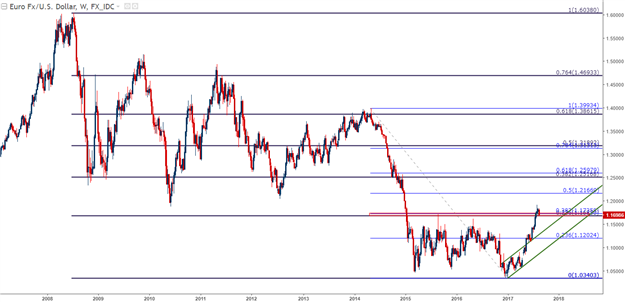
Chart prepared by James Stanley
On a shorter-term basis, we can see this support zone being tested, as price action is working below a trend-line that can be found by connecting the June 22nd and July 13th lows. As long as price remains supported above 1.1685, traders can entertain bullish scenarios. If this zone yields, subordinated support between 1.1585-1.1613 could be utilized for bullish swing approaches.
EUR/USD Hourly: Subordinated Support Applied from 1.1585-1.1613
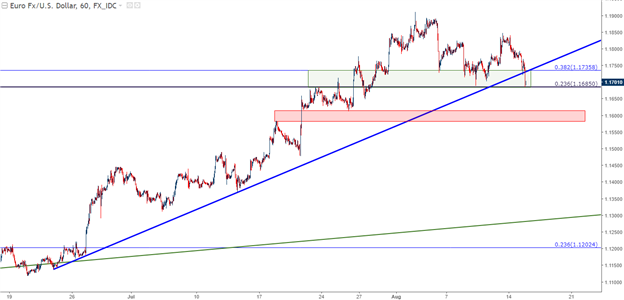
Chart prepared by James Stanley
Dollar Rises to Fresh Two-Week High
In yesterday’s article, we also looked at the U.S. Dollar after a troubling start to 2017. After coming into the year riding-high on the back of the inflation trade, the Greenback has spent most of the year spiraling-lower, as a combination of soft U.S. data was combined with a Federal Reserve that’s started to shift their focus to the balance sheet. This has many market participants rather skeptical on the prospect of a dual tightening mandate, in which the Federal Reserve simultaneously tightens the money supply through both higher rates and balance sheet reduction.
But in comments yesterday, NY Fed President Mr. William Dudley said that he felt the bank could put through one more hike in 2017 while also looking to reduce the balance sheet. This helped to bring a bit of strength into the Dollar, and after this morning’s Advance Retail Sales number blew-thru expectations, the Greenback is perching up to fresh two-week highs.
U.S. Dollar Hourly via ‘DXY’: Dollar to Two-Week High After Dudley Comments, Advance Retail Sales
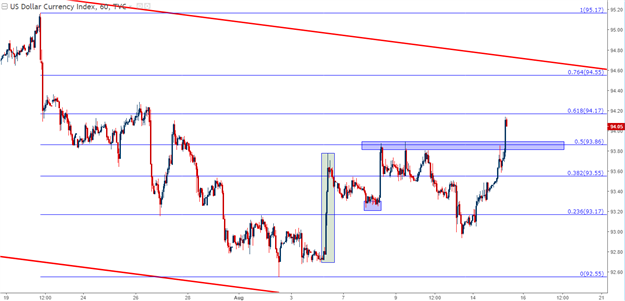
Chart prepared by James Stanley
We’re not out of the woods yet with U.S. data, as tomorrow brings meeting minutes from the Fed’s July rate decision, and on Friday we get University of Michigan Consumer Confidence, each of which are high-impact releases. For traders looking at long exposure in the Greenback, they’d likely want to pick their spots, as the Euro can remain volatile into week-end as we’re going to be seeing a number of drivers there. For long-USD plays, the British Pound (discussed below) and the Japanese Yen could be particularly attractive.
For USD/JPY, the pair is running up to fresh highs, but around the ¥111.00 psychological level is a batch of prior support/resistance that can be utilized for the bullish approach. Traders looking to get long can let this zone of potential resistance breach to indicate the potential for bullish continuation, at which point the goal would be get long after the ‘higher low’ shows up around prior resistance, fresh support.
USD/JPY Hourly: Approaching a Big Zone of Prior Support/Resistance Around ¥111.00
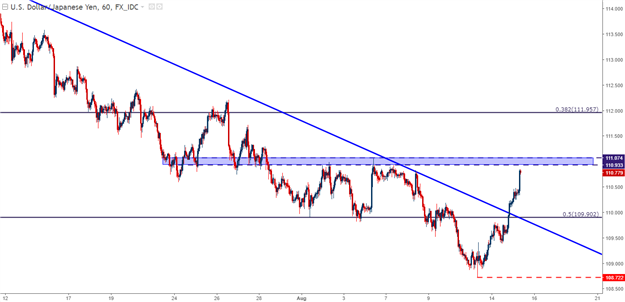
Chart prepared by James Stanley
Cable has very much been a recipient of USD weakness throughout this year, as the pair ran-up to a fresh 2017 high while the Dollar was driving down to fresh yearly lows. But since early-August, that tune appears to be changing after the dovish BoE rate decision at the beginning of the month was followed by that solid NFP report out of the United States.
This one-two combo sent GBP/USD below the vaulted 1.3000-level. And after last week brought another slew of slower-than-expected U.K. prints, this morning’s inflation report disappointed with another 2.6% read. And while this 2.6% number is still well-above the BoE’s inflation target of 2%, it’s likely not strong enough to compel the bank away from their uber-dovish monetary stance.
In response, the British Pound went spiraling-lower after this morning’s inflation read, and now prices are finding support on a bullish trend-line that started this March.
GBP/USD Four-Hour: Support Showing at Bullish Trend-Line Projection
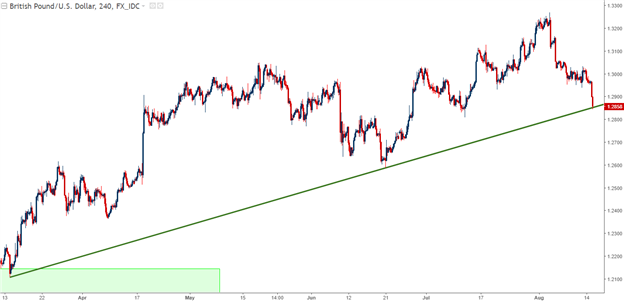
Chart prepared by James Stanley
As we discussed earlier this morning, this trend-line inflection can open the door to setups on both sides of Cable. For traders that want to fade this recent move of weakness, waiting for support to confirm around this trend-line would be crucial for the bullish approach. We discussed how traders can use price action to trade support and resistance in an educational article earlier in the month, and that methodology could certainly apply here.
On the bearish side of Cable – there are two attractive ways of moving-forward from here. Given that we’re at a potentially key support level, traders would likely want to be cautious of entering at the moment; instead electing to wait for a bit more information. If this support holds, traders can look to play ‘lower-high’ resistance around where previous support had shown, in the zone that runs from 1.2928-1.2955.
If this zone of support does break – traders can then look to catch resistance off of current support, which would be the zone that runs from 1.2809-1.2848.

Chart prepared by James Stanley
--- Written by James Stanley, Strategist for DailyFX.com
To receive James Stanley’s analysis directly via email, please SIGN UP HERE
Contact and follow James on Twitter: @JStanleyFX






